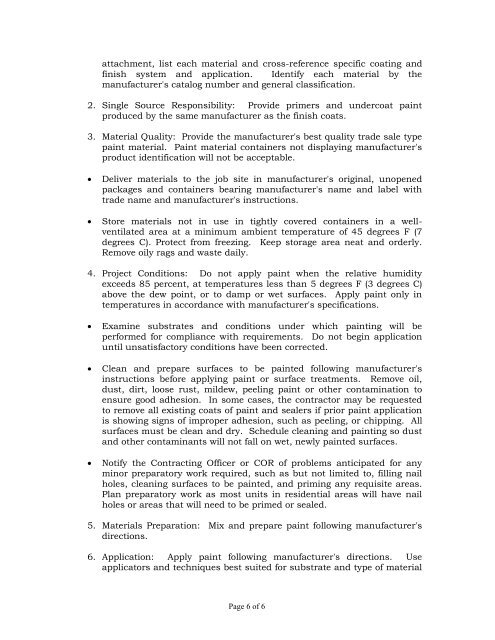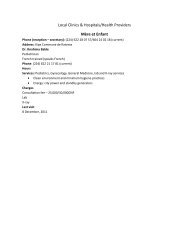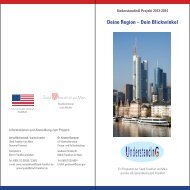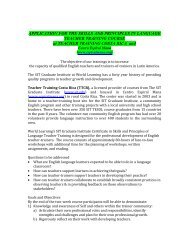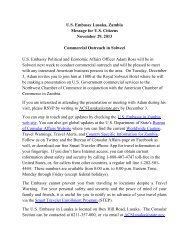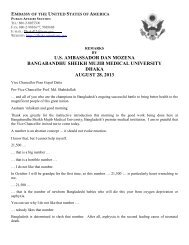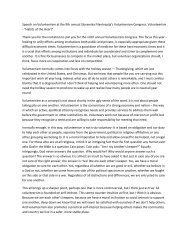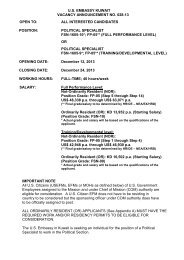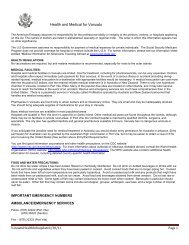Exterior painting of Enclave compound building, American Embassy
Exterior painting of Enclave compound building, American Embassy
Exterior painting of Enclave compound building, American Embassy
You also want an ePaper? Increase the reach of your titles
YUMPU automatically turns print PDFs into web optimized ePapers that Google loves.
attachment, list each material and cross-reference specific coating and<br />
finish system and application. Identify each material by the<br />
manufacturer's catalog number and general classification.<br />
2. Single Source Responsibility: Provide primers and undercoat paint<br />
produced by the same manufacturer as the finish coats.<br />
3. Material Quality: Provide the manufacturer's best quality trade sale type<br />
paint material. Paint material containers not displaying manufacturer's<br />
product identification will not be acceptable.<br />
<br />
<br />
Deliver materials to the job site in manufacturer's original, unopened<br />
packages and containers bearing manufacturer's name and label with<br />
trade name and manufacturer's instructions.<br />
Store materials not in use in tightly covered containers in a wellventilated<br />
area at a minimum ambient temperature <strong>of</strong> 45 degrees F (7<br />
degrees C). Protect from freezing. Keep storage area neat and orderly.<br />
Remove oily rags and waste daily.<br />
4. Project Conditions: Do not apply paint when the relative humidity<br />
exceeds 85 percent, at temperatures less than 5 degrees F (3 degrees C)<br />
above the dew point, or to damp or wet surfaces. Apply paint only in<br />
temperatures in accordance with manufacturer's specifications.<br />
<br />
<br />
<br />
Examine substrates and conditions under which <strong>painting</strong> will be<br />
performed for compliance with requirements. Do not begin application<br />
until unsatisfactory conditions have been corrected.<br />
Clean and prepare surfaces to be painted following manufacturer's<br />
instructions before applying paint or surface treatments. Remove oil,<br />
dust, dirt, loose rust, mildew, peeling paint or other contamination to<br />
ensure good adhesion. In some cases, the contractor may be requested<br />
to remove all existing coats <strong>of</strong> paint and sealers if prior paint application<br />
is showing signs <strong>of</strong> improper adhesion, such as peeling, or chipping. All<br />
surfaces must be clean and dry. Schedule cleaning and <strong>painting</strong> so dust<br />
and other contaminants will not fall on wet, newly painted surfaces.<br />
Notify the Contracting Officer or COR <strong>of</strong> problems anticipated for any<br />
minor preparatory work required, such as but not limited to, filling nail<br />
holes, cleaning surfaces to be painted, and priming any requisite areas.<br />
Plan preparatory work as most units in residential areas will have nail<br />
holes or areas that will need to be primed or sealed.<br />
5. Materials Preparation: Mix and prepare paint following manufacturer's<br />
directions.<br />
6. Application: Apply paint following manufacturer's directions. Use<br />
applicators and techniques best suited for substrate and type <strong>of</strong> material<br />
Page 6 <strong>of</strong> 6


